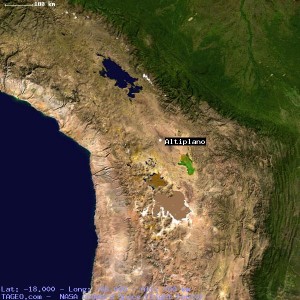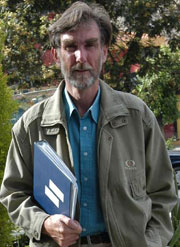Tony Morrison
Morrison, Tony
Tony Morrison is probably best known for his definitive work on the Nazca Lines, Pathways to the Gods[1036]. Tony and Marion Morrison have developed the South American Pictures.com website in order to show their extensive life-work. Unfortunately, the southamericanpictures website went offline but now, many of the image collections have been reassembled and are again available online(b).
In 1998 Morrison published a number of papers provocatively entitled The Bolivian Atlantis(b-e). They cover familiar territory – Tiwanaku, Pumapunku, Posnansky, Bellamy, Fawcett, Sykes, Blashford-Snell. This was the same year that Jim Allen published his Atlantis: The Andes Solution[877]. Had Allen not done so, I suspect that Morrison might have produced a more detailed book himself as apparently he and a colleague, Mark Howell, had built up quite a dossier on the subject.
Surprisingly, Morrison did not mention the mysterious puquios of the Nazca region(f), which, with the aid of satellite imagery(g), have been shown to have been part of a sophisticated hydraulic system that supplied water to an extremely arid locality.
*(a) https://nonesuchexpeditions.com/south-american-pictures/sap-archaeology-history-index.htm*
(b) https://www.nonesuchexpeditions.com/South-American-Pictures/sap-archaeology-history-index.htm
(f) https://www.flickriver.com/photos/tags/puquios/interesting/
(g) https://www.bbc.com/future/story/20160408-the-ancient-peruvian-mystery-solved-from-space
Bolivia *
 The Altiplano of Bolivia has most of its western half situated in the central Andes which includes the Altiplano (High Plateau). Jim Allen, a Scot, has promoted this region[040](a) as the true home of Plato’s Atlantis. Allen claims that ‘Andes’ is a corruption of Antis, a local word that means copper and that the same language uses Atl to denote water. He has identified a site known as Pampa Aullagas as the most likely location of Atlantis. The radical nature of this idea has ensured it widespread attention and sometimes scathing criticism.
The Altiplano of Bolivia has most of its western half situated in the central Andes which includes the Altiplano (High Plateau). Jim Allen, a Scot, has promoted this region[040](a) as the true home of Plato’s Atlantis. Allen claims that ‘Andes’ is a corruption of Antis, a local word that means copper and that the same language uses Atl to denote water. He has identified a site known as Pampa Aullagas as the most likely location of Atlantis. The radical nature of this idea has ensured it widespread attention and sometimes scathing criticism.
Although I cannot subscribe to Jim Allen’s Bolivian location for Atlantis, there is little doubt that Bolivia has yet to reveal all its secrets. For example, there are the little known Sajama lines in western Bolivia near the border with Chile and Peru. These straight Sajama Lines ”average between one and three meters wide, and run from a few meters to several kilometers. The longest of them are about twenty kilometers in length.”(m) Unlike the Nazca lines those at Sajama do not represent any creatures.
Very little research has been carried out on these lines, but I note that Evan Hadingham touched on the subject in Lines to the Mountain Gods[1309] noting that Tony Morrison, who had previously filmed the lines at Nazca[1036], stumbled on those at Sajama, and was told by locals that the lines joined sacred shrines. This was similar to what was told to the noted French anthropologist, Alfred Métraux in the 1930’s.
Returning to the subject of Atlantis, I continue to ask both why or how a mountainous kingdom on the west of South America would attack Athens on the eastern extremity of the Mediterranean is not clear! Allen’s theory concentrates on comparing the topography on the Altiplano with Plato’s description. He compared the physical features described by Plato with the site on the Altiplano and found that there was a very close match except that all the dimensions were out by a factor of two. This he explains by pointing out that unlike the Greeks, the pre-Columbian South Americans used a base 20 for counting. Allen also points to a naturally occurring alloy of copper and gold that is to be found in the Andes as the origin of the Orichalcum mentioned by Plato.
In an effort to strengthen his theory Allen suggests that the bull sacrifice on Atlantis, recorded by Plato, was in fact a reference to llama sacrifices(b)practiced in the Andes for thousands of years right up to the present! He argues that since the Egyptians would have had no word for llama they substituted ‘bull’ for it instead. Although llamas are camelids, I would have thought that they were closer in appearance to goats than bulls. Goat sacrifice is commonplace in the Southern Mediterranean and across much of Asia and has been for millennia. I consider Allen’s suggestion overly speculative and highly improbable.
Atlantisrevealed.com is a website(d), in English and Italian, which supports Jim Allens’s theory of Atlantis on the Altiplano of Bolivia. Unfortunately, it adds little new to the debate. Contrasting that is a lengthy and balanced critique of Allen’s ideas on Timothy Stephany’s website(e). He concludes that there is currently insufficient evidence to justify Allen’s claims.
Advocates of a South American Atlantis have pointed to the discovery of cocaine traces, derived exclusively from the South American coca plant, found in Egyptian mummies as evidence of ancient trans-Atlantic links and a possible channel for the spread of story of the destruction of Atlantis.
David Antelo, a Bolivian engineer, has also proposed a plain, in the Beni region just north of Allen’s site, as the location of Atlantis. In January 2011, Allen’s website included an extensive selection of aerial photos(c) of topographical features in Beni which suggest the pre-existence of an advanced civilisation in the region.
The oldest settlements so far found in Bolivia’s Amazon region are dated at 10,400 years old(f). A recent report(g) has shown numerous large circular earthworks throughout the Bolivian and Brazilian Amazon region. It also reported that the same territory, until recently forest, was savannah as recently as 2,000 or 3,000 thousand years ago.
Near the end of the 19th century, Emeterio Villamil de Rada (1804-1880) created quite a stir when he was the first to suggest that the Garden of Eden had been situated in the Andes and for good measure that the Aymara language was the language of Adam. Comparable ideas were expressed by Ramiro Gonzales Yaksic (1966- ) is the Bolivian author of Earthly Paradise: The Garden of the Andes[1055] in which he claims to have identified the biblical Garden of Eden in his native Bolivia(h). Dieter Groban has written in support of Yaksic(n).
In 2003 Jay Weidner & Vincent Bridges published a book[608] supporting an Andean location for Atlantis(o) in neighbouring Peru. Weidner & Bridges subsequently fell out(i) and Bridges has been accused of organising a scam by Laura Knight-Jadczyk(j).
(a) https://web.archive.org/web/20200811094111/http://www.atlantisbolivia.org/atlantisboliviapart1.htm
(b) https://web.archive.org/web/20190120200652/http://www.atlantisbolivia.org/bullsatlantis.htm
(c) https://web.archive.org/web/20200703083909/http://www.atlantisbolivia.org/beni.htm
(e) See: Archive 2237
(g) https://www.pnas.org/content/early/2014/07/03/1321770111.abstract
(h) See: Archive 2331
(i) https://www.cassiopaea.org/cass/clarification.htm
(j) https://www.cassiopaea.org/cass/vincent-bridges-scam.htm
(l) https://cffbolivia.blogspot.ie/2010/06/ramiro-gonzales-yaksic.html see (h)
(m) https://www.amusingplanet.com/2017/09/the-mysterious-sajama-lines-of-bolivia.html
(n) https://www.facebook.com/Groben.Turismo/posts/926029544094509
(o) Atlantis in the Andes (archive.org) *
Allen, J.M.
J.M. Allen, a Scotsman, worked in the 1970’s as an expert in satellite mapping with the British Royal Air Force. He was also a researcher of ancient measuring systems. The combination of these two interests led to a  conviction that Plato’s Atlantis could be matched with a site in the Altiplano of Bolivia,which he outlined in his book Atlantis: The Andes Solution[0040]. Coincidentally, in the same year, Tony Morrison published an article entitled The Bolivian Atlantis(k-n).
conviction that Plato’s Atlantis could be matched with a site in the Altiplano of Bolivia,which he outlined in his book Atlantis: The Andes Solution[0040]. Coincidentally, in the same year, Tony Morrison published an article entitled The Bolivian Atlantis(k-n).
Allen’s case is primarily based on the discovery of a vast canal network in the region together with aerial photography indicating concentric rings on the ground. His chosen site of Pampa Aullagus contains red, white and black rock reminiscent of the Atlantean masonry described by Plato.
In a TV documentary that focused on his theory it was suggested that the other nine kingdoms that comprised the Atlantean domain were probably to be found in South America.
>>Allen has also written Decoding Ezekiel’s Temple(a), which discusses ancient measuring methods and concluded that the temple described by Ezekiel was in fact a Babylonian ziggurat(o).<<
In 2008 Allen delivered three papers to the 2nd Atlantis Conference[750] in Athens. All three papers are available online in a pdf format(g)(h)(i).
2009 saw the publication of a second book, Atlantis: Lost Kingdom of the Andes[207] designed to reinforce his original thesis of Atlantis on the Altiplano of Bolivia. A trilogy was completed in 2010 with the publication of The Atlantis Trail (Kindle)which records his travels in the Andes in search of Atlantis(b). A small hotel is now being built in Pampa Aullagus to cater for increased number of tourists, no doubt in response to the work of Jim Allen.
In 2012, Allen published Atlantis and the Persian Empire, which is available to download as a free pdf file(c). This work is really just a reprise of his earlier writings. In this somewhat provocatively titled book he claims that Plato took the geography of the Atlantis story from the Andes, a theme he has been promoting since 1998.
However, he also maintains that the military history in Plato’s narrative was based on the war between Athens and the Persian Empire in the 5th century BC. Another of his more exotic claims is that the Sea Peoples were from South America. Allen devotes a considerable part of the book to ancient South American metrology and ends with a comparison of relative merits of the Altiplano versus Santorini as the inspiration behind Plato’s Atlantis story.
An extensive critique of Allen’s theories is offered by Timothy J.Stephany on his website(e). Nevertheless, although I consider Allen’s basic theory regarding Atlantis unacceptable, I find that part of his website showing images(f) of an extensive range of artefacts demonstrate most eloquently that South American civilisation was heavily influenced by distant cultures, both east and west.
Support for Allen’s views has continued into 2013(d), despite those elements of his theory that still conflict with Plato’s narrative: dating, dimensions and the improbability of an invasion of the eastern Mediterranean by a force from the west coast South America! However, I have found that in 1900, Peter de Roo devoted chapter seven of his History of America before Columbus[890.v1] to a review of the idea that at various times native Americans travelled eastward and among other things were responsible for the settling of Egypt!
Allen’s site offers an extensive article on the life and research of Posnansky, including excerpts from his work(j).
(a) https://web.archive.org/web/20200811094111/http://www.atlantisbolivia.org/atlantisboliviapart1.htm
(b) https://web.archive.org/web/20180831185831/http://www.atlantisbolivia.org/theatlantistrail.htm
(d) https://beforeitsnews.com/beyond-science/2013/03/atlantis-in-south-america-the-evidence-2441492.html
(e) See: Archive 2237
(f) https://web.archive.org/web/20200629021253/http://www.atlantisbolivia.org/artefacts.htm
(g) https://web.archive.org/web/20200718165434/http://www.atlantisbolivia.org/athensfullpaper.pdf
(h) https://web.archive.org/web/20200626174734/http://www.atlantisbolivia.org/athensfullpaper2.pdf
(i) https://web.archive.org/web/20200714051300/http://www.atlantisbolivia.org/athensfullpaper3.pdf
(j) https://web.archive.org/web/20190717211749/http://www.atlantisbolivia.org/posnansky.htm
(l) https://web.archive.org/web/20110520012247/http://southamericanpictures.com/features/feat4/dawn.html
